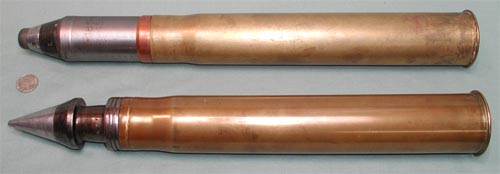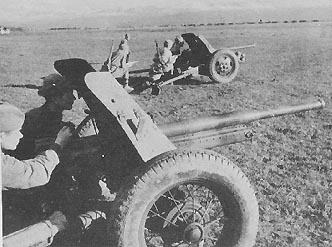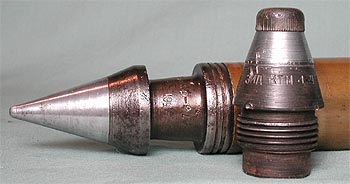 (The brass cases are the same - perpective distortion.) | |
 Russian Light Anti-Tank Gun, M1942
Russian Light Anti-Tank Gun, M1942Here are two rounds used by the Russians in their 45mm Light Anti-Tank Gun. An HE round at top, and AP with tracer element. Basically a scaled up version of the German 37mm Rheinmetall antitank gun, it was pretty much out dated by 1942, when the picture at left was taken. (The Germans used the nomenclature 4,5cm Pak 184(r) for captured guns.) Photo from: the guns 1939-45 Ian V. Hogg - 1970 |

Since the mid-1800's armor piercing shot & shell were made from hardened steel. However, to obtain effective penetration of modern tanks, projectiles needed to be fired at ever increasing velocities. While technology was able to meet the demand for speed, the projectiles would shatter on impact at about 824mps (2,800fps). To overcome this, a harder material alternative was selected using tungsten carbide. Unfortunataly, being much denser than steel, a full caliber round would be too heavy to reach a useful velocity. (Not to mention a waste of the strategic metal.) This approach, developed by the Germans, used a sub-caliber penetrating core surrounded by a lighter metal jacket. To further eliminate weight and increase velocity, material was removed from the center section, producing this characteristic "arrowhead" shape. This design is all but obsolete today, being replaced by discarding sabot types (APDS) which use a depleted uranium core. |
|
|
a.k.a. APCR - Armour Piercing, Composite Rigid - British HVAP - High Velocity Armor Piercing - U.S. |

